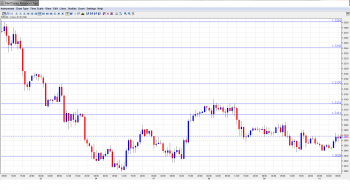EUR/USD remains steady, despite more weak economic data out of Germany. On Wednesday, German Industrial Production was released. The news was not pretty, as the manufacturing indicator increased by a paltry 0.2%, well below the market forecast. In other news, the ECB holds a policy meeting on Thursday, its first of the year. The ECB is not expected to change its benchmark interest rate of 0.75%, but the markets will be keeping a close eye on any announcements out of Brussels. French Industrial Production looked sharp, hitting a three-month high. In the US, today’s highlight is Unemployment Claims.
EUR/USD Technical
- Asian session: Euro/dollar edged down, but recovered and consolidated at 1.3062. The pair is unchanged in the European session.
- Current range: 1.3030 to 1.3110.
Further levels in both directions:
- Below: 1,3030, 1.30, 1.2960, 1.2880, 1.28, 1.2750, 1.2690, 1.2624, 1.2590, 1.25 and 1.2440.
- Above: 1.3110, 1.3130, 1.3170, 1.3240, 1.3290, 1.3350, 1.34 and 1.3480.
- 1.3030 continues to provide support, but this line is not strong. This is followed by support at 1.30.
- 1.3110 is a strong resistance line.
Euro/dollar steady despite weak German data – click on the graph to enlarge.
EUR/USD Fundamentals
- 7:45 French Industrial Production. Exp. 0.2%. Actual 0.5%.
- 7:45 French CPI. Exp. 0.4%. Actual 0.3%.
- 12:45 ECB Minimum Bid Rate. Exp. 0.75%.
- 13:30 ECB Press Conference.
- 13:30 US Unemployment Claims. Exp. 361K.
- 15:00 US Wholesale Inventories. Exp. 0.2%.
- 15:30 US Natural Gas Storage. Exp. -185B.
- 18:00 US 30-year Bond Auction.
- 18:10 US FOMC Member Esther George Speaks.
- 19:00 US FOMC Member James Bullard Speaks.
For more events and lines, see the Euro to dollar forecast
EUR/USD Sentiment
- Markets Wait for ECB Rate Announcement: All eyes will be on Brussels on Thursday, as the ECB holds an important policy meeting. The markets are not expecting a change to the current benchmark interest rate of 0.75%, but will be listening carefully for any hints of future cuts sometime in 2013. At the previous meeting, there was strong support for a rate cut, but this was rejected due to the concern that it could trigger market uncertainty. For now, the ECB is likely to make do with unconventional monetary steps as it tries to help along the Eurozone economy.
- Eurozone greets 2013 with weak numbers : We may have started a new year, but there hasn’t been much of a change in Eurozone data. After some disappointing PMI’s last week, unemployment continues to be major headache, with the Italian unemployment rate down a notch to 11.1%, and the Eurozone rate stuck at 11.8%. For any recovery to get on track, these kinds of numbers will have to improve. The euro did not react negatively to the data, but more bad economic news will certainly hurt the shaky currency.
- What’s wrong with Germany?: Early on in 2013, the once mighty German economy is showing signs of weakness. After some positive employment and retail sales numbers, this week’s data has been all downhill. The Trade Balance surplus dropped to its lowest levels since May, and German Factory Orders fell by 1.2%. There was no relief from German Industrial Production. Although the indicator managed to push into positive territory for the first time since September, the gain was a paltry 0.2%, well below the estimate of 1.1%. The weak numbers threaten to undermine confidence in the Eurozone’s largest economy. Chancellor Angela Merkel is seeking a third term in national elections in September, but she will have her work cut out for her if the German economy fails to improve.
- Japan purchases ESM bonds: Japanese Finance Minister Taro Aso stated on Tuesday that Japan plans to purchase bonds from the European Stability Mechanism, which is the Eurozone’s bailout fund.The ESM will begin issuing bonds immediately. This will be the first time that the ESM has issued securities since it was formed last October. Finance Minister Aso said that the move will help bring more stability to the Eurozone, which in turn will also help stabilize the yen and other currencies. Clearly, the Japanese government’s primary motivation in purchasing bonds from the ESM is not to save the Euro-zone or the euro. The purchase of the bonds, which will be made with Japanese yen, will allow Prime Minister Shinzo Abe to continue to weaken the Japanese currency (and strengthen the euro at the same time) without sustaining further criticism from the US and other countries, who are worried about the aggressive economic stance of the new government and its call for unlimited easing by the Bank of Japan.
- Congress braces for next round: The markets cheered last week’s fiscal cliff agreement in Washington, but it appears that this was just the first of more bruising battles ahead. The hard-fought agreement, which was preceded by months of acrimony and bad blood between the Republicans and Democrats, was criticized by many analysts and economists as a deal comprised of the lowest common denominator which both sides could reluctantly compromise and agree on. However, the agreement left two critical issues for another day – the debt ceiling and spending cuts. The problem is, the clock on those issues is also winding down, as the debt ceiling will be reached in February, and action will have to be taken to avoid a default on the country’s debt. Otherwise, the real possibility of a US default will likely cause turmoil in the markets.

